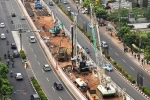Railway project: High-speed railway ready to zoom off
This article has been translated by PwC Indonesia as part of our Indonesia Infrastructure News Service. PwC Indonesia has not checked the accuracy of, and accepts no responsibility for the content.
Bisnis Indonesia - Proyek perkeretaapian: Kereta cepat siap melesat
30 January 2023
By: Loreno A. Mahardhika and Hendra Wibawa
Jakarta-Bandung high-speed railway (KCJB) project that is set to operate in July this year needs the commitment of regional governments so that it is connected to other modes of transportation.
Soon, the distance between Jakarta and Bandung in West Java will be increasingly closer. Travel between the two cities is predicted to only take 40 minutes, while previously it took around 3 hours.
This forecast refers to the plan to operate Jakarta-Bandung high-speed railway in the middle of this year.
PT Kereta Api Indonesia (Persero) President Director Didiek Hartantyo said that the progress of Jakarta-Bandung high-speed railway had reached 84%.
According to him, PT Kereta Cepat Indonesia China (KCIC) is currently laying the tracks and working on the signalling facility that are predicted to be completed in March 2023.
After both works are finished, KCIC will carry out testing and commissioning.
“At the end of May, we will carry out a trial approaching the commercial cooperation date in July 2023,” he said when he visited Jakarta-Bandung high-speed railway on Saturday (28/1).
KCIC is a joint venture of an Indonesian state-owned enterprise (SOE) consortium PT Pilar Sinergi BUMN Indonesia (PSBI) that owns 60% of the shares and a Chinese railway consortium Beijing Yawan HSR Co. Ltd. that owns 40% of the shares.
PSBI’s leader is PT Kereta Api Indonesia (KAI), while the Chinese consortium is led by CHINA RAILWAY International Co. Ltd.
Jakarta-Bandung high-speed railway project has conducted a trial on 16 November 2022 during the G20 Summit in Bali.
Didiek mentioned that KCIC operated a trainset from Tegalluar Station to Kopo Station in Bandung that is 18 kilometres away. The trial process went smoothly even though the trainset reached a speed of 80 kilometres per hour.
Didiek continued that five trainsets had arrived in Indonesia. Four more trainsets are planned to arrive in May 2023.
During the occasion, Transportation Minister Budi Karya Sumadi stated that KCJB was meaningful to Indonesia.
According to him, the development of the high-speed railway that connects Jakarta and Bandung is the first in Southeast Asia.
“This is the first high-speed railway in Southeast Asia, the speed can reach 350 kilometres per hour,” Budi Karya said.
He predicts that KCJB can improve the mobility of the people and be one of the backbones of transportation development in Indonesia.
He continued that the government was currently developing other modes of transportation to sustain the people’s mobility, such as Jakarta MRT.
At the start, he affirmed that many parties complanied about the budget required to build the KCJB project. However, Budi Karya said that the fund was not comparable to the cost spent to handle traffic congestion in Jakarta and Bandung.
“Everyone knows that the cost of traffic congestion reaches trillions of rupiah. MRT can largely contribute to reduce the loss,” he said.
Besides cutting the loss from traffic congestion, he continued that the high-speed railway project also helped PT KAI and PT KCIC acquire new knowledge during construction.
To support KCJB’s preparation process, the Transportation Ministry is also establishing collaborations with two consultants from the UK.
“We hope that we will learn many things that can be a capital to develop high-speed railways in Indonesia,” he said.
In the middle of January 2023, the Transportation Ministry signed commitments of cooperation (COCs) with PT Mott Macdonald Indonesia and The Crossrail International.
The two UK companies will facilitate the preparation of Jabodebek LRT and KCJB.
Budi Karya reckoned that the UK was one of the countries with the best experiences in constructing railway infrastructure with various technologies and innovations.
Jabodebek LRT and KCJB use sophisticated technologies. Jabodebek LRT is developed using communication-based train control (CBTC) and a grade of automation (GoA) level 3 system that make it possible for Jabodebek LRT to operate without a driver.
On the contrary, KCJB uses the GSM-R system, which is the first time it is used in Indonesia.
Integration problem
Generally, the main problem of mass transportations in Indonesia is connectivity.
Indonesia Transportation Society (MTI) Advocacy and Community Affairs Head Djoko Setijowarno hopes that KCJB is encouraged to involve regional governments more in regions where the high-speed railway travels through.
He reckoned that it was important so that regional governments can help prepare feeders from and to housing and settlement areas.
On the other hand, PT KAI Public Relations VP Joni Martinus stated that the company had prepared two railway services that will connect Jakarta and Bandung city centres with high-speed railway stations. The services are Jabodebek LRT and KCJB Feeder Train.
By using Jabodebek LRT, customers only need to travel 20 minutes from Dukuh Atas Jabodebek LRT Station to Halim Jabodebek LRT Station.
Later, customers can directly transfer from Halim Jabodebek LRT Station to Halim KCJB Station as both services have been integrated at the same location.
In Bandung, PT KAI is continuously preparing facilities and infrastructure to operate KCJB Feeder Train. The feeder train facility consists of five KRDE trainsets with a capacity of 280 passengers on each trainset that consists of five carriages.
Joni added that PT KAI ensured that the transfer between modes of transportation and platforms, waiting rooms, and facilities had been made as comfortable and as easy as possible.


















